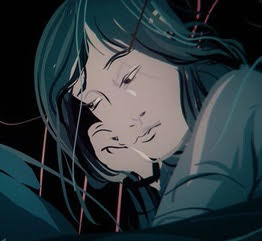
When my cousin told me he was taking a course called Storytelling in Virtual Reality, I finagled an invitation to visit. (He’s working on a master’s degree in NYU’s Integrated Digital Media program.) You’d be interested too, right?
I met my cousin a few hours early to get a primer on virtual reality, about which my knowledge was dim. Wearing a black headset that encased my eyes and offered speakers for my ears, I entered several VR stories, each time surrounded 360 degrees by a fully dimensional alternate world.
For example, in one story, I stood in a forest where trees towered hundreds of feet above me and birds soared over my head. In another, I was suspended in a black space. A girl, drawn three-dimensionally in colored ink, floated nearby. (That’s her in the picture to the right.) She wrote a letter to her mother, the words appearing in space around me, and I gradually learned more about the relationship between mother and daughter, new images of them appearing around me, in different places and sizes.
After each story, it was a shock when I removed the headset and found myself in a regular room with walls and ceiling, plugged into a souped-up laptop.
The class was equally fascinating. The students will be creating their own VR stories, or at least parts of them, and the night I attended they presented their project ideas. A brief sampling:
After the oceans submerge most of Earth’s landmass, people live in underwater cities. Your hand motions propel you through the water, like you’re swimming. (Experiential touches like this can be used in VR.)
A horror tale in which you must keep your heart rate down (it’s measured) to survive.
A child is released from a mental hospital. He celebrates his birthday with family, blowing out candles. Balloons float, then fall, turning into water. Which is really blood because, in reality, he just killed everyone in the room. (All the more startling when presented by a shy young woman with pink hair.)
The possibilities for story and sensory experience are limitless. And I was left wondering: Is VR a gimmick or game-changer? Will this be the dominant mode of storytelling in 20 or 50 years? Is this a viable way to tell meaningful stories?
I was also left marveling at how, with a bit of skill, writers can make us experience things so vividly using nothing more high-tech than the letters of the alphabet. A very simple example from Frances Mayes’s memoir Under the Tuscan Sun:
Apricots, a little basket of rising suns, and bunches of field lettuce still wet with dew.
I see it, feel it, taste it.

Alex Steele
President


